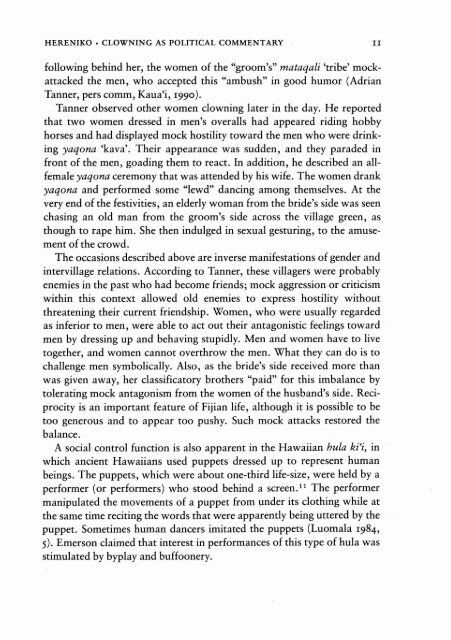Clowning as Political Commentary: Polynesia, Then ... - ScholarSpace
Clowning as Political Commentary: Polynesia, Then ... - ScholarSpace
Clowning as Political Commentary: Polynesia, Then ... - ScholarSpace
Create successful ePaper yourself
Turn your PDF publications into a flip-book with our unique Google optimized e-Paper software.
HERENIKO • CLOWNING AS POLITICAL COMMENTARY II<br />
following behind her, the women of the "groom's" mataqali 'tribe' mockattacked<br />
the men, who accepted this "ambush" in good humor (Adrian<br />
Tanner, pers comm, Kaua'i, 1990).<br />
Tanner observed other women clowning later in the day. He reported<br />
that two women dressed in men's overalls had appeared riding hobby<br />
horses and had displayed mock hostility toward the men who were drinking<br />
yaqona 'kava'. Their appearance w<strong>as</strong> sudden, and they paraded in<br />
front of the men, goading them to react. In addition, he described an allfemale<br />
yaqona ceremony that w<strong>as</strong> attended by his wife. The women drank<br />
yaqona and performed some "lewd" dancing among themselves. At the<br />
very end of the festivities, an elderly woman from the bride's side w<strong>as</strong> seen<br />
ch<strong>as</strong>ing an old man from the groom's side across the village green, <strong>as</strong><br />
though to rape him. She then indulged in sexual gesturing, to the amusement<br />
of the crowd.<br />
The occ<strong>as</strong>ions described above are inverse manifestations ofgender and<br />
intervillage relations. According to Tanner, these villagers were probably<br />
enemies in the p<strong>as</strong>t who had become friends; mock aggression or criticism<br />
within this context allowed old enemies to express hostility without<br />
threatening their current friendship. Women, who were usually regarded<br />
<strong>as</strong> inferior to men, were able to act out their antagonistic feelings toward<br />
men by dressing up and behaving stupidly. Men and women have to live<br />
together, and women cannot overthrow the men. What they can do is to<br />
challenge men symbolically. Also, <strong>as</strong> the bride's side received more than<br />
w<strong>as</strong> given away, her cl<strong>as</strong>sificatory brothers "paid" for this imbalance by<br />
tolerating mock antagonism from the women of the husband's side. Reciprocity<br />
is an important feature of Fijian life, although it is possible to be<br />
too generous and to appear too pushy. Such mock attacks restored the<br />
balance.<br />
A social control function is also apparent in the Hawaiian hula ki'i, in<br />
which ancient Hawaiians used puppets dressed up to represent human<br />
beings. The puppets, which were about one-third life-size, were held by a<br />
performer (or performers) who stood behind a screen. ll The performer<br />
manipulated the movements of a puppet from under its clothing while at<br />
the same time reciting the words that were apparently being uttered by the<br />
puppet. Sometimes human dancers imitated the puppets (Luomala 1984,<br />
5). Emerson claimed that interest in performances of this type of hula w<strong>as</strong><br />
stimulated by byplay and buffoonery.
















